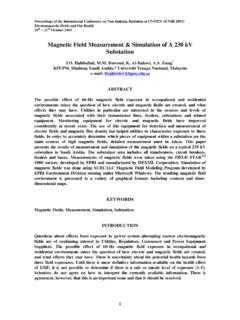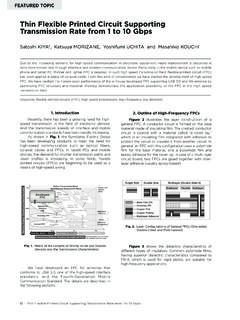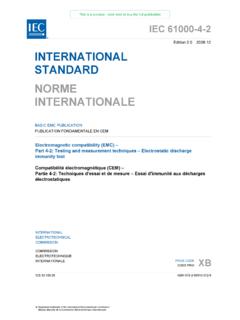Transcription of Multi-physics simulations for electrical machine development
1 RESEARCH REPORT VTT-R-04618-15 SIMPRO Multi-physics simulations for electrical machine development Authors: Janne Ker nen, Aino Manninen, Jenni Pippuri Confidentiality: Public RESEARCH REPORT VTT-R-04618-15 1 (17) Report s title Multi-physics simulations for electrical machine development Customer, contact person, address Order reference Tekes, Matti S yn tjoki Kyllikinportti 2, Box 69, FI-00101 Helsinki, FINLAND Tekes: 40204/12 Project name Project number/Short name Computational methods in mechanical engineering product development 100553/SIMPRO Authors Pages Janne Ker nen, Aino Manninen, Jenni Pippuri 18 Keywords Report identification code electrical machines, FEM, open-source, Elmer, parallelisation, computation, simulation VTT-R-04618-15 Summary In electrical machine R&D, like in other fields, different computation methods are needed for different purposes. For detailed analysis and product design, a multi-physical finite element (FEM) analysis is required.
2 However, if advanced multi-objective optimisation of electro-mechanical devices is pursued, the computational burden of FEM analysis is too high, and more simple analytical models are needed. In this study, both alternatives are discussed. One hot topic in FEM computations has lately been the utilisation of open-source FEM tools. The benefits of open source can be found in massive parallel computation, more vast scripting possibilities, and possibility to tailor the software for special usage. Here, we study open-source FEM tools for three-dimensional (3D) electromagnetic and multi-physical simula-tion of electrical machines. The two most promising tools are Elmer and GetDP. We present two electrical machine test cases with Elmer. Elmer and GetDP are presently only open-source tools, which can solve 3D electromagnetic problems. However, they lack features needed for rotating electrical machine computations, they have limitations with the rota-tion model.
3 The limitations are more severe in GetDP. The parallel performance of Elmer ex-ceeds the results of GetDP, as GetDP utilises parallel computation only in linear solvers, whereas Elmer also in linear system assembly. Furthermore, in the test cases, Elmer shows a good parallel performance with rotating electrical machine models. Additionally, optimisation of electrical machines was studied. An analytical model implement-ed in MATLAB was used to represent an electrical machine in the optimisation process. Both single and multi-objective algorithms were tested in DAKOTA optimisation tool. Confidentiality Public Tampere Written by Janne Ker nen, Research Scientist Reviewed by Pavel Ponomarev, Research Scientist Accepted by Johannes Hyrynen, Head of Research Area VTT s contact address VTT Technical Research Centre of Finland, Box 1000, FI-02044 VTT, FINLAND Distribution (customer and VTT) Tekes/Matti S yn tjoki, 1 copy VTT/archive, 1 copy The use of the name of the VTT Technical Research Centre of Finland (VTT) in advertising or publication in part of this report is only permissible with written authorisation from the VTT Technical Research Centre of Finland.
4 RESEARCH REPORT VTT-R-04618-15 2 (17) Contents 1 Pre-study of Multi-physics simulation for electrical machine development .. 3 Introduction: Modelling of electrical machines .. 3 Numerical modelling of electrical 3 Analytical model for electrical machines .. 4 Open-source FEM tools for electrical machine computation .. 5 GetDP .. 6 Elmer .. 7 Other tools .. 8 electrical machine optimisation .. 8 2 Experiences with Elmer .. 9 Elmer usage .. 9 Elmer case study models .. 10 Results .. 12 3 electrical machine optimisation with DAKOTA .. 14 DAKOTA .. 14 Results and discussion .. 14 4 Acknowledgements .. 15 References .. 16 RESEARCH REPORT VTT-R-04618-15 3 (17) 1 Pre-study of Multi-physics simulation for electrical machine de-velopment Introduction: Modelling of electrical machines Design of electrical machines requires a good command of multi-physical phenomena includ-ing electromagnetism, mechanics, thermodynamics, structural dynamics, vibration, noise, fluid dynamics, and fatigue.
5 The functioning of the machines rises from electromagnetic phe-nomena connected with mechanical rotation and connected electrical circuits. Here, we con-centrate on researching the multi-physical simulations combining the latter three fields of physics. As electrical machines design is inheritably multi-physical, its accurate three-dimensional (3D) modelling has been out-of-question until recently. The computational burden has been too heavy for traditional computation tools and hardware. Another reason is that 3D magnetic eddy-current problems require quite nonstandard modelling structures of numerical mathe-matics compared to structural analysis, where Finite Element Method (FEM) is originated from. Other comparative traditional methods, like Finite Volume Method, are not directly applicable either. Hence, traditional methods for electrical machines research and design have been analytical and two-dimensional (2D) FEM approaches.
6 Relatively simple analytical or semi-analytical approaches may be applied for the standard motor topologies, especially in the initial electromagnetic designing or optimisation. Further and more detailed investigations are founded on a numerical discretised solution of the electromagnetic field. However, there is still a need for both analytical and numerical FEM solutions. Numerical modelling of electrical machines Numerical 2D electromagnetic computation is a standard tool in design and analysis of elec-tromechanical apparatuses. 2D can be used, if only a certain cross section of the machine needs to be modelled to completely represent the machine s behaviour. 2D modelling is most commonly used for radial flux machines, machines where the magnetic flux flows radially in the air gap with respect to the shaft of the machine (the shaft-directional component of the magnetic flux density can be assumed to be zero) and the electrical current density is assumed to be in the direction of the shaft.
7 The 3D features are neglected or modelled separately. For example, the end effects of radial flux machines are commonly dealt with additional (circuit or analytical) models to 2D FEM. Let us clarify the differences of the 2D and 3D cases. Generally, both in 2D and 3D, magnetic flux density inside the machine can be found from following partial differential equation, along with proper boundary and initial conditions, 1curlcurlgradsAAVJt , ( ) where A is the magnetic vector potential, V the electrical scalar potential, Js the known source current, the permeability of the material, and the electrical conductivity. The above is so-called A-V formulation for eddy current problems. V is nonzero only in conducting regions, whereas A exists in the whole domain. After solving ( ), the magnetic flux density and elec-trical field strength can be solved from B = curl A and E = A/ t grad V. In 2D, the unknown magnetic vector potentials have only one component (normal to the 2D plane) and the potential can be modelled with standard nodal FEM functions, whereas in 3D the so-called edge element basis functions are required.
8 The change from nodal elements to RESEARCH REPORT VTT-R-04618-15 4 (17) edge element causes very heavy changes is simulation code, above the natural dimension changes. For example, the numerics of the curl-curl operator in ( ) are totally different from those of div-grad in the 2D-version of ( ). To be precise, the stiffness matrix from curl-curl is singular, if no special treatment (gauging) is done to squeeze a non-singular submatrix. Further, integral of A/ t along the conductors behaves as a source term for the electrical cir-cuits connected to the machine . In reverse direction, the circuits are coupled to the electro-magnetic field problem via the electric scalar potential V. In 2D, the conductors need to be perpendicular to the 2D plane ( z-directional). Then, V is constant in the 2D cross section of each conductor and constantly varies in the z-direction. This makes circuit connection in 2D quite simple; connection is established directly via variables dV/dz and Az.
9 In 3D, V does not change linearly along z-axis, but its dependence on any spatial dimension is free inside a conductor. If connected with electronic circuit equations, V s values in so-called connector areas are connected with external circuit equations. Due to these differences between 2D and 3D models along with natural size difference of the 2D and 3D discretised models 2D models have had tolerable computational times al-ready from 1980s, but 3D problems still need days to weeks to be solved with commercial software. Especially the computation is intolerably slow, when the machine s core materials are assumed to be conducting, eddy currents in the core are taken into account in the prob-lem formulation. Parallel computation can be seen as a solution for this, but none of the pre-sent commercial electrical machine FEM modelling software tools effectively take maximum advantage from parallelism.
10 Further, due to this multi-physical nature of the computation and the unique features of 3D eddy current computation ( edge elements and rotor mesh rota-tion), this can be seen as niche market for commercial FEM software vendors. Thus, here we concentrate on researching the status of open-source FEM tools for multi-physical electrical machine simulations . Availability of electromagnetic computational software is good, and both commercial and open-source providers are well presented. Commercial providers include, for instance, Ansys Maxwell [1], Cedrat Flux [2], COMSOL Multi-physics [3], JSOL JMAG [4], and Cobham (formerly Vector Fields) Opera [5]. Perhaps the most well-known open-source software for FEM numerical modelling are GetDP [6] and Elmer [7]. Though the number of different nu-merical electromagnetic codes is rather large, only few of them are capable of coping with all the special features that are associated with rotating electrical machines.















